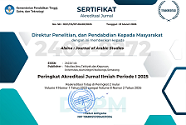Efektivitas Penggunaan Peta Konsep Kitab Sharḥ Qaṭr al-Nadá wa-Ball al-Ṣadá pada pembelajaran Nahwu di Perguruan Tinggi Islam
DOI:
https://doi.org/10.21580/alsina.5.1.21017Keywords:
Arabic grammar, mind map, nahwu, readingAbstract
This study aims to evaluate the effectiveness of using the mind map from the Kitab Sharḥ Qaṭr al-Nadá wa-Ball al-Ṣadá in enhancing the learning of Qawāid Naḥwīyah among first-year students in the Arabic Language Education program at UIN Walisongo Semarang, class of 2023, consisting of 27 students. The research employed a quasi-experimental method with a one-group pre-test and post-test design. The researchers conducted data analysis using a t-test to assess the improvement in learning outcomes. The results showed that the average post-test score (75.11) increased significantly compared to the average pre-test score (44.44), with a p-value of 0.000, indicating a high significance level. These findings suggest that the intervention effectively improved the student's learning outcomes. Thus, the use of the concept map from the Kitab Sharḥ Qaṭr al-Nadá wa-Ball al-Ṣadá has proven to be an effective teaching strategy for Qawāid Naḥwīyah among students.
Downloads
References
AF, Mildan, Nurhayati Nurhayati, and Istikomah Istikomah. “Vocabulary and Grammar Mastery on Students’ Reading Skill.” Scope : Journal of English Language Teaching 6, no. 1 (2021): 30–36. https://doi.org/10.30998/scope.v6i1.10237.
An’im, Abu. Sang Pangeran Nahwu al Jurumiyah: pengantar memahami dan mahir matan al jurumiyah. Jawa Barat: Mujizat Grup, 2016.
Angelina, Vitri, Eka Nur Khikmah, Fikri Hamdani Ubaidilah, and Kisno Umbar. “Problematika Pemahaman Nahwu Mahasantri Yayasan Munashoroh Indonesia (YMI) Pusat.” Jurnal Pendidikan & Ilmu Bahasa Arab 2, no. 1 (2023): 28–42. https://doi.org/10.31764/ljpb.v2i1.12723.
Anshari, Thoriq Al. “Tahlil Kitab Sharh Qatr Al Nada Wa Bal Al Sada Li Ibn Hisyam Al Anshary Min Jihati Madhahibi an Nahwiyyati Wa Atsarahu Fi Ta’limi Qawaidi Al Nahwiyyati Bi Ma’hadi Dar Al Muttaqin Batu.” UIN Maulana Malik Ibrahim Malang, 2019.
Anwar, Moch. Ilmu Nahwu: terjemahan matan al-jurumiyah dan ‘imrity berikut penjelasannya. 40th ed. Bandung: Sinar Baru Agresindo, 2016.
Aqil, Ibnu. Terjemahan Alfiyah Syarah Ibnu Aqil. Translated by Bahaud Din Abdullah, Abu Bakar Bahrun, Anwar Abu Bakar, and Sufyana Li. Bandung: Sinar Baru Agresindo, 2017.
Dahlan, Ahmad Zainy. syarh mukhtasor jiddan. Semarang: Toha Putra, n.d.
Firdausiyah, Zahroh, and Muallim Wijaya. “Implementasi Metode Mindmapp Dalam Pembelajaran Ilmu Nahwu Siswi XI Program Keagamaan MAN 1 Probolinggo.” لساننا (LISANUNA): Jurnal Ilmu Bahasa Arab dan Pembelajarannya 13, no. 1 (2023): 11–26. https://doi.org/10.22373/ls.v13i1.18026.
Gunawan, Heri, Andewi Suhartini, Asep Nurshobah, and Ilyas Rifa’i. “Penyusunan Materi Pembelajaran Qawaid Nahwiyah Dalam Kitab Al-Jurumiyah.” Dialog 41, no. 2 (2020): 237–48. https://doi.org/10.47655/dialog.v41i2.305.
Haris, Abdul. Teori Dasar Nahwu & Sharf. Jember: Al Bidayah, 2018.
Ibn Hishām, ʿAbd Allāh ibn Yusuf Al-Anshārī. Sharḥ Qaṭr al-Nadá wa-Ball al-Ṣadá. Beirut: Al-Maktabah al-ʿAṣrīyah, 1994.
Kausari, Ahmad, Ridha Darmawaty, and Fatwiyah Noor. “The Model of Kitab Mutammimah Al-Ajurumiyyah Card Series Development Based on Mind Mapping for Student’s Grammar Learning.” Al-Ta’rib : Jurnal Ilmiah Program Studi Pendidikan Bahasa Arab IAIN Palangka Raya 11, no. 1 (2023): 111–26. https://doi.org/10.23971/altarib.v11i1.6480.
Khaironi, A. Shahib. Al Arabiyyah li Ghairi al Arab. Jatibening: WCM Press, 2010.
———. Audhah al Manahij. Jatinbneing: WCM Press, 2008.
Kojin, Kojin, and Choiruddin Choiruddin. “Learning Nahwu Using Mind Mapping Method in a Modern Islamic Boarding School.” AL-ISHLAH: Jurnal Pendidikan 14, no. 4 (2022): 6603–10. https://doi.org/10.35445/alishlah.v14i4.2758.
Li, Y., Y. Chai, and H. Yan. “The Effect of Mind Mapping on Student Academic Performance: A Meta-Analysis of 10 Years’ International Mind Mapping Practice.” Distance Education in China 1 (2018): 16–28. https://doi.org/10.13541/j.cnki.chinade.2018.01.002.
Liu, Ting, and Takaya Yuizono. “Mind Mapping Training’s Effects on Reading Ability: Detection Based on Eye Tracking Sensors.” Sensors 20, no. 16 (2020): 4422. https://doi.org/10.3390/s20164422.
Mawardi, Kholid. Problematika Pembelajaran Nahwu di Institut Agama Islam Negeri (IAIN) Syekh Nurjati Cirebon: Studi Kualitatif pada Mahasiswa Jurusan Pendidikan Bahasa Arab dan Jurusan Bahasa dan Sastra Arab (Master Thesis). Bandung: Universitas Pendidikan Indonesia, 2020.
Muassomah, Muassomah, Penny Respaty Yurisa, and Mohd Firdaus Bin Yahaya. “Mind Mapping: Reading Comprehension Technique of Arabic Texts for Students in Higher Education.” Jurnal Al Bayan: Jurnal Jurusan Pendidikan Bahasa Arab 14, no. 2 (2022): 438–55. https://doi.org/10.24042/albayan.v14i2.14350.
Munir. Perencanaan Sistem Pengajaran Bahasa Arab. Jakarta: Kencana, 2017.
Nur, Ifa Rodifah Nur, Fairuz Subakir Ahmad, Haulia Husna, and Nahla Tailakh. “Fa’āliyah Mind Mapping Li Tarqiyah Natāij Ta’allum Al Thalabah Fī Mādah Al Nahwi.” Ta’lim Al-’Arabiyyah: Jurnal Pendidikan Bahasa Arab & Kebahasaaraban 6, no. 2 (2022): 204–22. https://doi.org/10.15575/jpba.v6i2.20278.
Putra, Arifdo, Mahyudin Ritonga, and Hetti Waluati Triana. “Optimizing Nahwu Learning: Combination of Electronic and Conventional Mind Mapping.” Thariqah Ilmiah: Jurnal Ilmu-Ilmu Kependidikan & Bahasa Arab 11, no. 2 (2023): 158–72. https://doi.org/10.24952/thariqahilmiah.v11i2.9481.
Rofiqoh, Iriani Faizah, Subiki Subiki, and Aris Singgih Budiarso. “Identifikasi Kemampuan Berpikir Kreatif Siswa dengan Metode Mind Mapping pada Pembelajaran Fisika Pokok Bahasan Optik di SMA.” Jurnal Pembelajaran Fisika 9, no. 4 (2020): 139. https://doi.org/10.19184/jpf.v9i4.18359.
Seena, Endah, and Nashirudin. “Eksperimentasi Metode Mind Map pada Pembelajaran Nahwu Bahasa Arab untuk Meningkatkan Hasil Belajar Siswa.” al Mahāra: Jurnal Pendidikan Bahasa Arab 5, no. 1 (2019): 85–100. https://doi.org/10.14421/almahara.2019.051-05.
Shi, Yinghui, Huiyun Yang, Yi Dou, and Yong Zeng. “Effects of Mind Mapping-Based Instruction on Student Cognitive Learning Outcomes: A Meta-Analysis.” Asia Pacific Education Review 24, no. 3 (2023): 303–17. https://doi.org/10.1007/s12564-022-09746-9.
Sidik, Anwar, and Muassomah Muassomah. “Implementasi Metode Mind Mapping Dengan Menggunakan Media Power Point Dalam Pembelajaran Nahwu.” Alsina : Journal of Arabic Studies 3, no. 2 (2021): 241–60. https://doi.org/10.21580/alsina.3.2.6734.
Sugiyono. Metode Penelitian Pendidikan (Pendekatan Kualitatif, Kuantitatif & RnD). Bandung: Alfabeta, 2015.
Tony Buzan. Buku Pintar Mind Map. Jakarta: Gramedia Pustaka Utama, 2012.
Wahyudin, Dedih. Metodologi Pembelajaran Bahasa Arab. Bandung: Remaja Rosda Karya, 2020.
Downloads
Published
How to Cite
Issue
Section
License
Copyright
The copyright of the received article shall be assigned to the publisher of the journal. The intended copyright includes the right to publish the article in various forms (including reprints). The journal maintains the publishing rights to published articles. Authors are allowed to use their articles for any legal purposes deemed necessary without written permission from the journal, but with an acknowledgment to this journal of initial publication.
Licensing
In order for Alsina: Journal of Arabic Studies to publish and distribute research articles, the editors need publishing rights (transferred from author to publisher). This agreement relates to the transfer/publishing copyright license to Alsina: Journal of Arabic Studies but the authors still have significant rights to use and share their published articles.
Alsina: Journal of Arabic Studies supports the need for writers to share, disseminate and maximize the impact of their research and their rights on any database. As a journal article writer, you have the right to various uses of your articles, including that by the institution or company where you work. Copyright can be used without the need for special permission. Authors who publish articles in the Alsina: Journal of Arabic Studies have broad rights to use their work for teaching and scientific purposes without requesting permission, including:
- Use by the author for lectures, presentations, or conferences, with distribution of copies to participants;
- Distribution to colleagues for research use;
- Use in compilations of the author's subsequent work;
- inclusion in a thesis or dissertation;
- Reuse of sections or excerpts from articles in other works (with full acknowledgment of the final article);
- Preparation of derivative works (other than commercial purposes) (with full acknowledgment of the final article);
- Voluntary posting on open websites operated by authors’ or writers' agencies for scientific purposes
When submitting a manuscript, authors do so on the understanding that if accepted for publication, the copyright for publishing (publishing right) of the article shall be assigned/transferred to Alsina: Journal of Arabic Studies.
Authors whose articles are accepted for publication will receive confirmation via email and sent a Copyright Transfer Agreement.


 Accreditation
Accreditation 
 In Collaboration with
In Collaboration with 

 Visitors
Visitors  Article Template
Article Template





